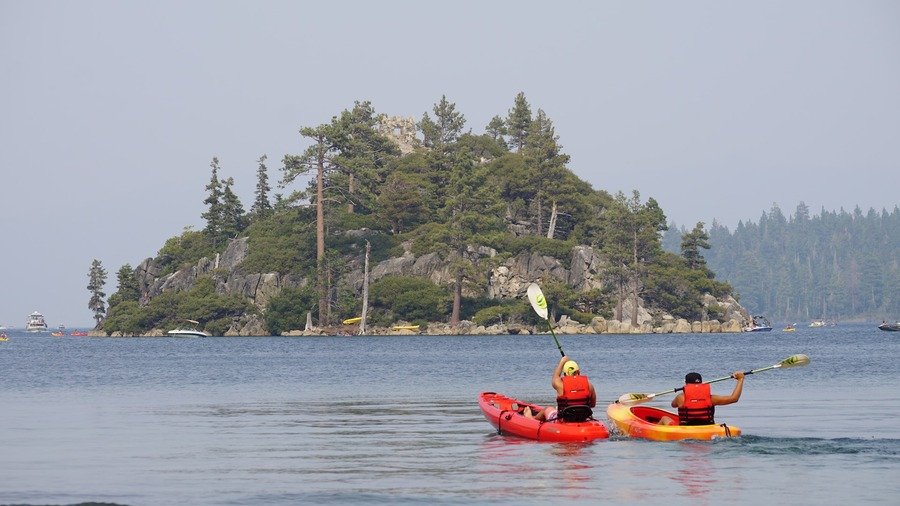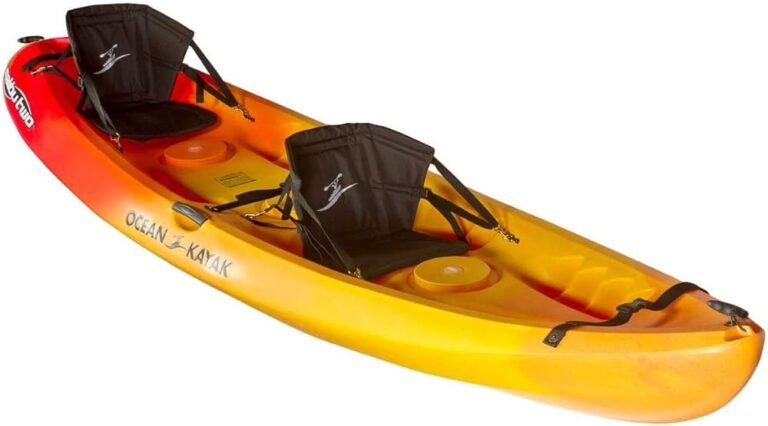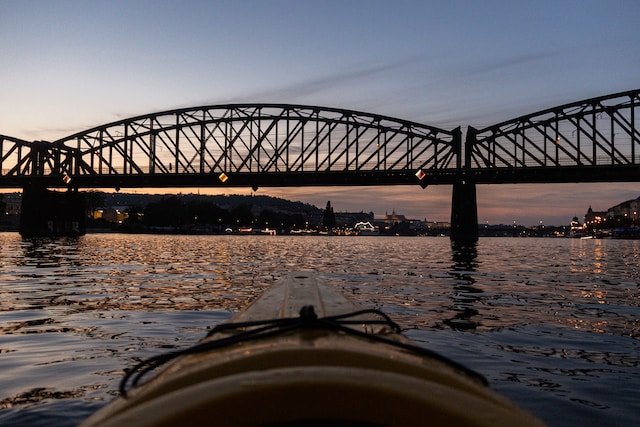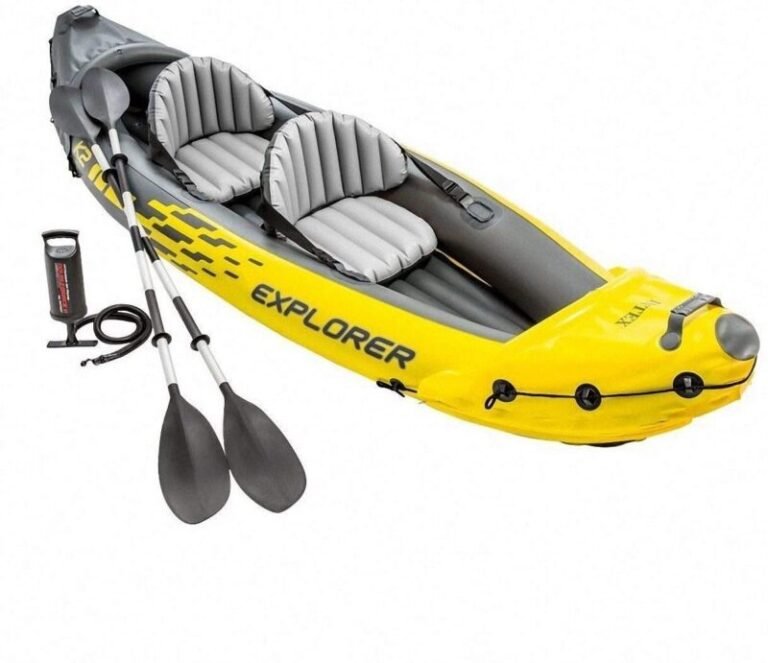Kayaking Terminologies: A Comprehensive Guide

Kayaking involves moving a small watercraft known as a kayak on water by the use of a double-bladed paddle. From leisure paddling to adrenaline-pumping whitewater sessions, kayaking offers a diverse range of experiences.
Whether you’re a casual kayaker or a serious athlete, understanding kayaking terminology is crucial for safe and effective navigation.
What Is A Kayak?
A kayak is a small human-powered watercraft propelled using a two-bladed paddle. Kayaks come in a range of different designs and sizes, each tailored to specific activities and water conditions.
The types of kayaks include recreational kayaks, touring kayaks, sea kayaks, whitewater kayaks, sit-in kayaks, and sit-on-top kayaks.
Sea Kayaks
Sea kayaks are built for open-water adventures, providing stability, speed, and ample storage. They have a longer profile for increased speed and tracking, along with a skeg or rudder to aid in course correction.
Whitewater Kayaks
Whitewater kayaks are built for adrenaline junkies and thrill-seekers. They come in various styles, including playboats, river runners, and creek boats.
These kayaks are short, highly maneuverable, and designed to handle the turbulent and fast-flowing waters of rivers and rapids. They have a reinforced hull to withstand impacts with rocks and obstacles.
Touring Kayaks
Touring kayaks, also known as sea touring or expedition kayaks, are designed for long-distance kayaking trips on open water. They have a longer and narrower profile compared to recreational kayaks, which enhances their speed and tracking abilities.
Recreational Kayaks
Recreational kayaks are the go-to choice for beginners and casual paddlers. They are characterized by their wide, stable hull design, making them easy to maneuver and maintain balance in calm waters.
These kayaks typically have a large cockpit, making it simple for paddlers to enter and exit. They are often shorter in length, which aids in turning and navigating tight spaces.
Sit-On-Top Kayaks
Sit-on-top kayaks have an open design with a molded seat on top of the hull, rather than an enclosed cockpit. They are known for their stability, ease of entry, and self-draining design, making them popular for warm-weather paddling.
Sit-In Kayaks
Sit-in kayaks have a more conventional appearance and as a result, are simple to spot. As the name indicates, a sit-inside kayak has an enclosed cockpit. This positions the paddler below the water’s surface rather than above the water level as in sit-on kayaks.
Basic Anatomy of a Kayak
A kayak’s anatomy plays an important role in its performance, stability, and functionality. Let’s dive in.
The Kayak Hull
The hull is the foundational structure of a kayak, defining its behavior on the water. There are various hull types, each with its own characteristics:

Image Source: https://www.sniffoutdoors.com/ultimate-guide-to-kayaks/
V-Shaped Hull
V-shaped hulls have a pointed bottom that cuts through the water efficiently. They offer better secondary stability, meaning they become more stable as you lean the kayak on its side.
These hulls are designed for speed and agility. They are commonly found in sea kayaks and are ideal for open water and ocean kayaking, where tracking and stability in waves are crucial.
Flat-Bottomed Hull
These hulls are exceptionally stable, making them ideal for beginners and recreational paddlers. They offer good initial stability, which means the kayak feels steady when you first get in.
Flat-bottomed hulls are suitable for calm waters, such as lakes and slow-moving rivers. They excel in tracking (maintaining a straight course) but are less maneuverable in rough conditions.
Pontoon Hull
Also known as a “pontoon” or “twin hull” design, this hull type features two parallel hulls, offering exceptional stability.
Pontoon hulls are commonly used in fishing kayaks, as they provide a stable platform for casting and reeling. They are also suitable for standing in the kayak.
Round-Bottomed Hull
The contours of this hull design feature rounded edges, making it ideally suited for navigating in ocean waters or swiftly flowing rivers.
Rounded hulls are great at providing better maneuverability and stability, particularly in turbulent waters as opposed to calm, flat surfaces.
Bow and Stern
The bow is the front section of the kayak. It is the part of the kayak that leads and slices through the water. The shape and design of the bow affect the kayak’s speed and maneuverability.
The stern is the rear section of the kayak. The stern often houses the kayak’s rudder or skeg, which assists in tracking and steering. The design of the stern can impact how easily the kayak can be turned.
Cockpit Rim
The cockpit rim is the upper edge of the cockpit, and it plays an important role in securing the kayak spray skirt. The spray skirt is a waterproof cover that seals the cockpit, preventing water from entering the kayak.
The skirt is secured around the cockpit rim, creating a watertight seal. This is particularly important in rough water conditions to keep the paddler dry and the kayak buoyant.
The Kayak Deck
The kayak’s deck is the top part of the vessel, and it includes several key components:
The Cockpit
The cockpit is the seating area where the kayaker sits, it provides a secure and comfortable seating position. It can vary in size and shape depending on the type of kayak.
The Footrests
Footrests, also known as foot pegs or braces, are adjustable supports for the kayaker’s feet within the cockpit. Properly positioned footrests help provide and maintain better stability and control by allowing the kayaker to brace their feet against them while paddling.
The Seat
The seat is where the kayaker sits in the cockpit. A well-designed seat provides better comfort during long paddling sessions and provides support for the lower back as well.
The Bulkheads
Bulkheads are partitions or walls inside the kayak’s hull that divide the interior into compartments. These compartments, often located at the bow and stern, serve multiple purposes:
- In the event of a capsize, bulkheads limit the amount of water that can enter the kayak, aiding in self-rescue and ensuring the kayak remains manageable.
- Bulkheads provide additional buoyancy, keeping the kayak afloat even if one compartment is flooded.
- They create sealed storage compartments where gear can be stowed, keeping it dry and secure.
Detailed List of Different Kayaking Terminologies
Bracing
Bracing is a kayaking technique used to maintain balance and prevent capsizing when encountering rough water or unexpected obstacles.
A high brace involves placing the paddle horizontally on the water’s surface with your arms raised, providing support and preventing the kayak from tipping over.
A low brace involves placing the paddle horizontally on the water’s surface with your arms lowered, providing stability and preventing the kayak from rolling.
Warping
Warping is the deformation in the kayak’s shape, and this can affect its performance and handling. Warped kayaks may not track or maneuver correctly.
Rolling
Rolling is an advanced kayaking maneuver used to recover from a capsized position by rolling the kayak upright without exiting the cockpit.
Successful rolling involves a combination of body movements, paddle placement, and precise timing. The Eskimo roll, C-to-C roll, and sweep roll are common rolling techniques used by kayakers.
Edging
Edging is a technique that involves tilting the kayak to one side by lifting one knee while lowering the other.
Edging allows kayakers to control the kayak’s direction and maneuverability. Tilting the kayak on the edge helps it turn more efficiently without the need for excessive paddle strokes.
Base Layers/Clothing Layers
Base layers are clothing layers, crafted from natural or synthetic materials (excluding cotton), that are worn beneath outer garments by paddlers. Quality base layers efficiently wick moisture away from the skin, providing warmth or cooling as needed.
Shortie
A paddle jacket with short sleeves.
Boofing
Boofing is an advanced whitewater kayaking technique used to safely navigate waterfalls, ledges, and other vertical drops.
To boof, kayakers perform a well-timed stroke and a forward-leaning movement, propelling the kayak forward and extending it horizontally over the drop to clear obstacles and land safely in the downstream water.
Spray Skirt
A nylon or neoprene skirt is worn by kayakers to seal off the kayak’s cockpit, preventing water from entering while protecting the legs from sun, wind, or rain.
Creeking
Creeking is a subset of extreme whitewater kayaking that focuses on navigating steep, technical, and often remote rivers with challenging drops and tight canyons.
Creeking involves specialized terminology, including “slot,” “gorge,” “slide,” “pillow,” and “sieve,” to describe features and hazards encountered in these demanding waterways.
Stackers
Rack accessories that aid in stacking and securing multiple kayaks on a car’s roof.
Eskimo Roll Technique
An Eskimo roll, or simply a “roll,” is a kayaking maneuver you use to recover from a capsized position by rolling the kayak upright without exiting the cockpit.
The Eskimo roll is a crucial self-rescue technique, allowing the kayaker to regain an upright position quickly and continue paddling without leaving the kayak.
Personal Flotation Device (PFD)
A PFD is a key piece of safety equipment that every kayaker must wear while out on the water. It provides buoyancy and keeps the kayaker afloat in the water, reducing the risk of drowning.
There are various types of PFDs, including Type I, Type II, Type III, Type IV, and Type V, each designed for specific water activities and conditions. Type V PFDs are lightweight and often specialized for kayaking and offer mobility and comfort.
T-Rescue Technique
The T-rescue is a kayaking rescue technique used to assist a capsized kayaker in righting their kayak. It involves two kayaks: one capsized (the “victim”) and one upright (the “rescuer”).
The rescuer’s kayak is positioned perpendicular to the victim’s kayak (forming a “T” shape), and the victim uses the rescuer’s kayak as support to perform a wet exit (leaving the capsized kayak). The victim then re-enters their kayak and continues paddling.
A Swimmer
In kayaking, a “swimmer” refers to a person who has fallen into the water after capsizing or exiting the kayak. Identifying a swimmer is crucial for rescue operations, ensuring that swift and appropriate action can be taken to assist the individual in the water.
Tow Leash
A lengthy piece of webbing, packed in a small bag, attachable to the paddler’s waist or rescue harness. It is used by kayak instructors for towing kayaks to shore during rescue operations and to assist fatigued paddlers.
A Throw Bag
A throw bag is a rescue tool consisting of a bag or pouch containing a length of rope. It is an essential piece of equipment for kayakers.
In rescue situations, a throw bag is thrown to a swimmer or another kayaker in distress. The person in the water can grab hold of the rope, allowing it to be safely pulled to shore or to an assisting kayak. Throw bags are vital for quick and efficient water rescues.
Neoprene
Neoprene is a synthetic rubber material known for its excellent insulating and waterproof properties.
Bilge Pump
A bilge pump is a hand-operated or battery-powered device used to remove water from the interior of a kayak.
Wet Exit
The process of swimming out of a kayak.
Paddle Blade
The paddle blade is the flat, wide part of the paddle that enters the water. It is responsible for generating movement. Blades come in various shapes and designs, including dihedral and asymmetrical blades.
- Dihedral Blade: A dihedral blade has two flat surfaces that form a V-shape when viewed from the side. This design reduces flutter and provides stability for your strokes.
- Asymmetrical Blade: are shaped with one side being shorter and more curved than the other. This design minimizes twisting during the stroke, resulting in a more efficient paddle stroke.
The Shaft
The shaft is the long, narrow part of the paddle that the kayaker grips. Shafts can be made from various materials, including aluminum, fiberglass, carbon fiber, and wood. Shafts come in different shapes, such as straight, bent, and ergonomic shafts.
- Straight Shaft: this has a simple, straight design. It offers a traditional grip and is commonly used by kayakers for general paddling.
- Bent Shaft: has a slight bend in the shaft. It provides a more ergonomic grip, reducing strain on the wrists and shoulders.
- Ergonomic Shaft: An ergonomic shaft is contoured to fit the natural shape of the hand. It enhances comfort and control, making it easier to maintain a proper paddling technique.
Tandem Kayak
A longer kayak featuring two cockpits and seats for two paddlers to paddle together, ideal for sharing kayaking experiences with friends and family.
Solo Kayak
A kayak featuring one cockpit and seats only one kayaker.
Thigh Braces
These are padded, contoured supports located inside the kayak’s cockpit, positioned against the kayaker’s thighs.
Feathering
Feathering refers to the angle at which the two blades of a kayak paddle are offset from each other. In a feathered paddle, the blades are set at an angle (typically 30 to 45 degrees) to each other.
Feathering reduces wind resistance when the blade is out of the water, making it easier to paddle in windy conditions.
In an unfeathered paddle, the blades are aligned straight with no offset. Unfeathered paddles are often preferred by beginners or in situations where quick blade transitions are needed.
The Grip
The grip is the handle at the top of the paddle shaft that allows for a secure hold. There are various grip types, including the T-grip and palm grip.
- The T-grip is shaped like the letter “T.” It provides a secure grip and allows the kayaker to control the angle of the blade.
- The palm grip is contoured to fit the palm of the hand. It offers comfort and a relaxed hand position during extended paddling sessions.
Paddle Strokes
Paddle strokes are specific techniques used to propel and maneuver the kayak. Here are some basic strokes:
- Forward Stroke: The forward stroke is the fundamental paddling technique used to move the kayak forward. The kayaker reaches forward, immerses the blade fully in the water, and pulls it backward, generating forward thrust.
- Sweep Stroke: The sweep stroke is employed for turning the kayak. The kayaker uses a wide, sweeping motion with the blade to one side of the kayak, which causes the kayak to turn in the opposite direction.
- Reverse Stroke: The reverse stroke is used for stopping or moving the kayak backward. The kayaker reaches backward, immerses the blade fully in the water, and pushes it forward, creating reverse propulsion.
- Draw Stroke: The draw stroke is used to pull the kayak sideways or toward an object. The kayaker places the blade in the water next to the kayak and pulls it toward the hull, creating a sideways movement.
Upstream and Downstream
“Upstream” indicates the direction against the flow of a river or current. When kayaking on a river, knowing which way is upstream is vital for planning your route and understanding the current’s force.
“Downstream” refers to the direction of the river or current’s flow. Paddling downstream typically requires less effort than paddling upstream, making it important to identify the downstream direction when navigating rivers.
Lee and Windward
The “lee” side of the kayak is the side sheltered from the wind. Paddlers often use the lee side to find shelter from strong winds and waves. It’s the side where you’re more likely to maintain control and stability.
The “windward” side of the kayak faces into the wind. Understanding windward is crucial for effective sea kayaking. Paddling on the windward side can be challenging due to wind resistance and waves, so it’s often best to avoid it when possible.
Port and Starboard
“Port” refers to the left side of the kayak when facing forward. These nautical terms are useful for clear and standardized communication among kayakers and boaters.
“Starboard” designates the right side of the kayak when facing forward. Understanding port and starboard helps prevent confusion and ensures everyone knows which direction to turn or maneuver.
Compass Rose
A compass rose is a graphical device that shows the cardinal directions: North, South, East, and West. Carrying a compass and being able to read a compass rose is valuable for sea kayakers and those navigating large bodies of water, as it provides a reliable reference for direction.
Chart and Compass
A nautical chart is a detailed map of a waterway, often used by sea kayakers to plan routes, identify landmarks, and understand the local geography.
Charts provide essential information for safe navigation, including water depths, tides, currents, and potential hazards. A compass is a navigation tool used to determine direction by aligning with magnetic north.
Sea kayakers use compasses in conjunction with charts to maintain course and navigate in open waters where visual landmarks may be limited.
A Rudder
A rudder is a movable blade located at the stern of the kayak, often attached to foot pedals in the cockpit. Its primary role is to assist with steering and maintaining course, particularly in windy or challenging sea conditions.
Kayakers can control the rudder’s position using foot pedals, allowing them to make precise adjustments to the kayak’s direction.
Kayak Skeg
A kayak skeg is a retractable fin or blade located on the kayak’s keel near the stern. Its primary function is to enhance tracking, which is the ability to maintain a straight course without excessive zigzagging.
Sea kayakers can adjust the skeg’s depth to control the kayak’s responsiveness to wind and currents. Lowering the skeg improves tracking in windy conditions while raising it increases maneuverability.
Deck Lines
Deck lines are a series of lines or ropes secured to the kayak’s deck, typically running along the bow, stern, and sides. They serve multiple purposes, including providing handholds for re-entry after a capsize, securing gear to the deck, and assisting in rescues.
Sea State
The sea state refers to the condition of the ocean’s surface, influenced by factors such as wind, wave height, and swell. Sea states are categorized using descriptive terms, including “calm,” “choppy,” “moderate,” “rough,” and “stormy,” to communicate ocean conditions effectively.
Understanding the sea state is important for planning trips and assessing the suitability of conditions for sea kayaking. Whitewater kayaking is both exhilarating and challenging from the kayaking standpoint.
Cam Straps
These are webbing straps with metal buckles used to secure kayaks on roof racks.
Kayak Racks
A system of bars mounted on a car’s roof to transport kayaks and other equipment like bikes and skis.
Eddies
An eddy is a calm, slower-moving area of water found behind rocks, in the lee of obstacles, or along the river’s edge. Kayakers often use eddies for resting, regaining control, and catching their breath in the midst of fast-moving water.
Eddies are also used for maneuvering within a rapid. Paddlers enter eddies to change direction, avoid obstacles, or position themselves for the next part of the descent.
Dry Bag
A waterproof and sealable bag used by paddlers to keep their items dry, including first aid kits and snacks during river trips.
Rapids
Rapids are turbulent sections of a river with fast-flowing water and various obstacles, such as rocks and waves. Rapids are classified into different classes, ranging from Class I (easy) to Class V (extremely difficult and dangerous).
- Class I: These are the easiest rapids with small waves and a gentle current, suitable for beginners.
- Class II: These are rapids with moderate waves and a slightly more challenging current, suitable for novice paddlers.
- Class III: These are intermediate rapids with larger waves and more complex currents, requiring solid kayaking skills.
- Class IV: These are advanced rapids with large waves, strong currents, and challenging obstacles, typically for experienced kayakers.
- Class V: These are expert-level rapids with extremely challenging features, often requiring expert paddling skills.
Booties
Booties are built and designed to fit snugly, allowing easy and comfortable use within a kayak to protect your feet.
Holes
A hole, also known as a “hydraulic,” is a turbulent water feature in a rapid where the water flows back upstream, creating a recirculating area.
Holes are often characterized by a central depression in the water surface and strong currents that can trap kayakers.
Holes are considered hazards, and kayakers aim to avoid getting caught in them as they can lead to capsizing and difficulty escaping the hydraulic.
Outfitting
Refers to adjustable features of your kayak, including the seat, back band, foot braces, etc that enhance the comfort and fit of a kayak.
Surfing
Surfing in whitewater kayaking involves riding waves, holes, or features in a rapid with precision and control. To surf effectively, kayakers adjust their angle to the wave or feature, using the flow of water to stay in place or move across the wave.
Portage
The act of carrying a kayak around a rapid, or obstacle instead of navigating the obstruction while in the kayak.
Drops
A drop refers to a steep descent or waterfall-like feature in a river or rapid. Drops can vary in height and gradient, and they often create a significant change in water elevation.
Paddlers use specific techniques to safely navigate drops, including leaning forward and maintaining proper posture to avoid capsizing.
Back Band
The back band is situated behind the seat and can be adjusted to keep you in an upright, active seated position. It basically offers essential lower back support.
Whitewater
This occurs when flowing water mixes with air to create aerated water. In rivers, whitewater forms when water flows over obstacles like rocks in the riverbed or when the river’s gradient increases, leading to a faster flow and turbulence.
Experience kayaking in a different light, learn the language lingo, and enjoy tangoing with your fellow kayakers. As you embark on your kayaking adventures, enjoy each bit of it.





